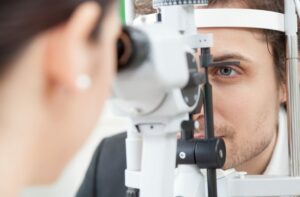Myopia Clinic
Understanding Myopia (Nearsightedness): Causes, Symptoms & Treatment at Vala Eye Centre in Vadodara
Myopia, commonly known as nearsightedness, is one of the most widespread vision problems across the world. With increasing screen time, reduced outdoor activity, and lifestyle changes, more people especially children and young adults are developing myopia at an earlier age. Understanding its causes, symptoms, and available treatments can help prevent long-term vision complications.
What is Myopia ?
Myopia, or nearsightedness, is a common refractive error of the eye that makes distant objects appear blurry while close objects remain clear. It occurs when the eyeball is slightly longer than normal or when the cornea (the front surface of the eye) has too much curvature. Because of this, light entering the eye focuses in front of the retina instead of directly on it leading to blurred distance vision.
In simpler terms, if you have myopia nearsightedness, you can read a book or look at your phone clearly, but faces across the room or road signs appear out of focus.
Myopia usually begins in childhood or adolescence and can gradually worsen as the eyes continue to grow. The condition has become increasingly common worldwide often linked to more screen exposure, indoor lifestyles, and limited outdoor time.
Eye care specialists now refer to this rapid global rise as the “myopia epidemic.” According to studies, by 2050, nearly half of the world’s population may develop some degree of myopia.
If left unchecked, myopia can progress into high myopia, increasing the risk of serious eye problems later in life, such as retinal detachment, cataracts, glaucoma, and macular degeneration. That’s why early detection and regular eye check-ups, especially for children in metro cities are essential for healthy vision.
Common Causes of Myopia
Several factors contribute to the development of myopia:
-
Genetics: Children with one or both parents who are myopic are at higher risk.
-
Prolonged screen exposure: Excessive use of phones, tablets, and computers strains the eyes.
-
Reading at close distances: Spending long hours reading or studying closely can increase risk.
-
Lack of outdoor time: Natural light exposure helps slow myopia progression, especially in children.
Symptoms of Myopia
If you notice any of the following symptoms, it’s advisable to visit an eye specialist for a comprehensive eye check-up:
-
Blurred vision while viewing distant objects
-
Frequent squinting or eye strain
-
Headaches after reading or using screens
-
Difficulty seeing the blackboard or road signs clearly
Diagnosis: How is Myopia Detected?
Detecting myopia is simple, quick, and completely painless. An eye specialist or optometrist can identify nearsightedness through a comprehensive eye examination that evaluates how well your eyes focus light.
Here’s what typically happens during a myopia diagnosis:
-
Visual Acuity Test (Eye Chart Reading):
You’ll be asked to read letters or symbols from a distance using one eye at a time. This helps measure how clearly you can see distant objects. -
Refraction Test:
The doctor uses a device called a phoropter to determine the exact lens power needed to correct your vision. You’ll look through different lenses and indicate which ones make your vision clearer. -
Retinoscopy:
In this test, the eye specialist shines a light into your eyes to observe how it reflects off the retina. This gives a quick and accurate estimate of your refractive error, especially useful for children who may not respond clearly to standard tests. -
Slit-Lamp Examination:
A microscope with a bright light allows the doctor to examine the cornea, iris, and lens to rule out other underlying issues that could affect focusing. -
Autorefractor or Computerized Eye Testing:
Many eye hospitals in Vadodara now use advanced computerized tools that automatically measure the shape of your cornea and how light bends inside your eye — helping confirm the degree of myopia precisely.
For children and teenagers, regular eye exams are crucial because myopia often progresses quietly, without obvious symptoms until vision becomes noticeably blurry. Schools and parents in metro cities are increasingly encouraged to include annual eye examprograms to detect myopia early and prevent complications.
If you experience frequent headaches, blurred distance vision, or eye strain, it’s best to book an appointment with Dr Ruchi Vala who is a qualified ophthalmologist and eye specialist with years of experience in Vadodara for a detailed examination and personalized care plan.
Treatment Options for Myopia at Vala Eye Centre
Myopia can be effectively managed with several treatment options available at Vala Eye Centre in Vadodara:
1. Prescription Glasses or Contact Lenses
The most common and non-invasive correction methods.
Modern options include anti-glare and blue light lenses for digital eye protection.
2. Orthokeratology (Ortho-K)
Special contact lenses worn overnight to reshape the cornea temporarily, providing clear vision during the day without glasses.
3. Laser Vision Correction (LASIK/SMILE)
For adults with stable prescriptions, LASIK or SMILE eye surgery at vala eye centre in Vadodara offers a permanent solution by reshaping the cornea using precision laser technology to preserve the eye health.
4. Myopia Control in Children
Pediatric myopia control treatments include:
-
Low-dose atropine eye drops
-
Special myopia-control lenses
-
Lifestyle guidance, including outdoor play and reduced screen time
Preventing Myopia Progression
While genetics can’t be changed, adopting healthy visual habits can significantly reduce risks:
-
Take regular breaks from screens (20-20-20 rule).
-
Increase outdoor activities for at least 1–2 hours daily.
-
Maintain proper lighting while studying or reading.
-
Get regular eye check-ups every 6–12 months.

